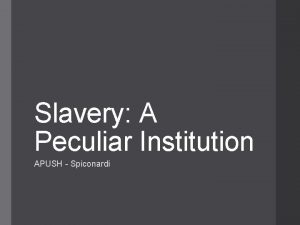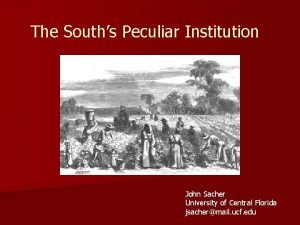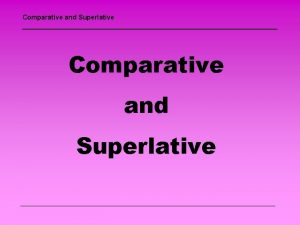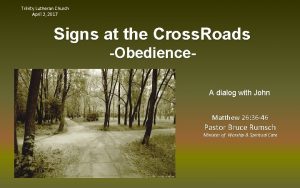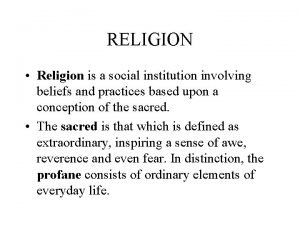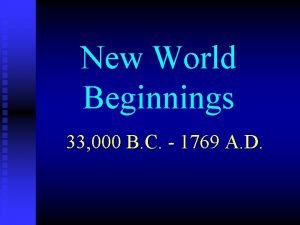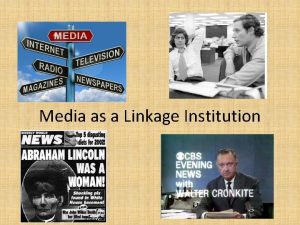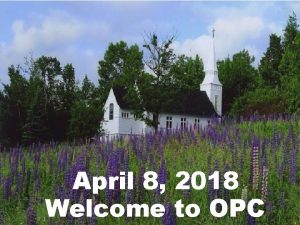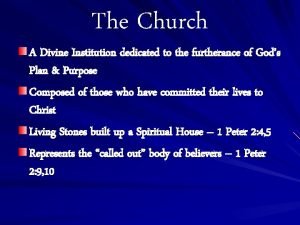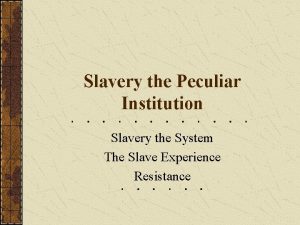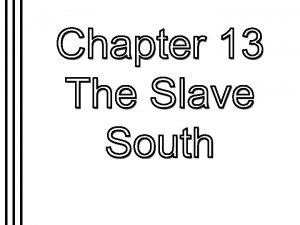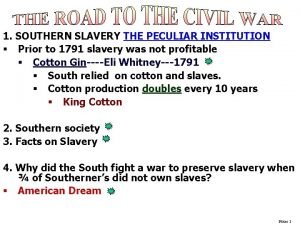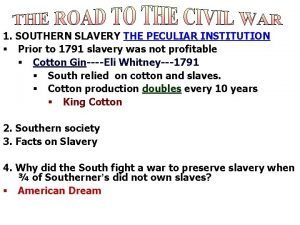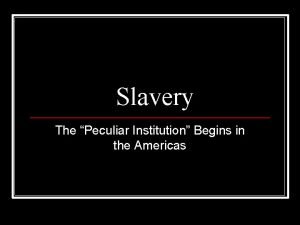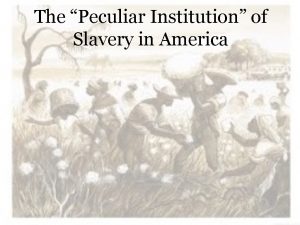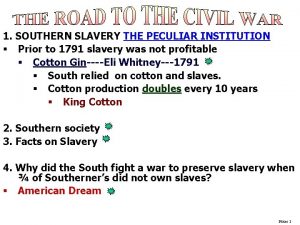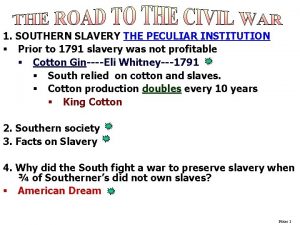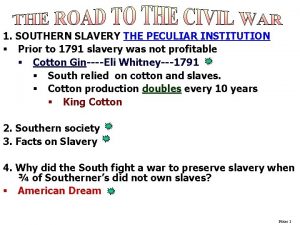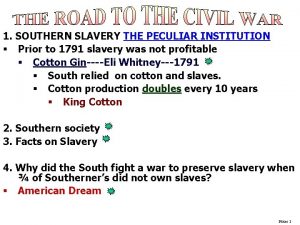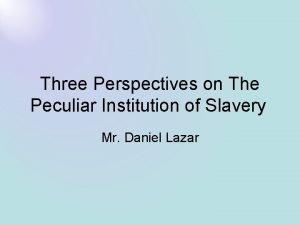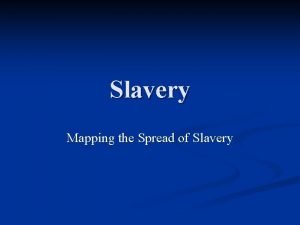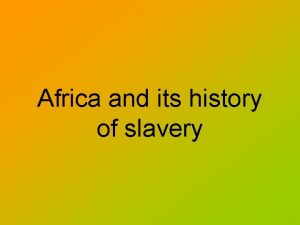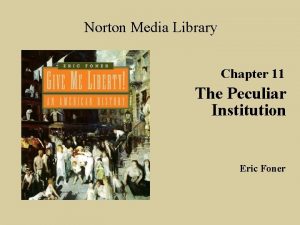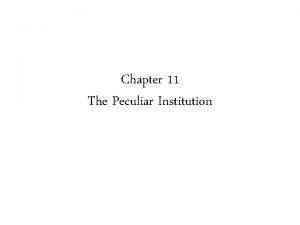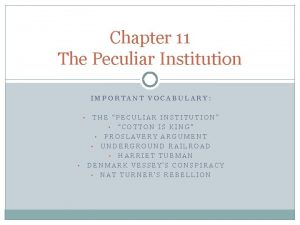Slavery The Peculiar Institution is slavery Its history























































































- Slides: 87


Slavery "The Peculiar Institution" is slavery. Its history in America begins with the earliest European settlements and ends with the Civil War. Yet its echo continues to reverberate loudly. Slavery existed both in the north and in the South, at times in equal measure. The industrialization of the north and the expansion of demand for cotton in the south shifted the balance so that it became a regional issue, as the southern economy grew increasingly reliant on cheap labor.

Slavery As is always true in history, cultures grow and thrive in all conditions. Two interdependent cultures emerged in the American south before the Civil War — the world the slaveholders created for themselves and the world of their slaves. Even though slaves were not permitted to express themselves freely, they were able to fight back even though enchained.

Slavery Although African-Americans had been brought to British America since the time of Jamestown colony, American slavery adopted many of its defining characteristics in the 19 th century. The cotton gin had not been invented until the last decade of the 1700 s. This new invention led the American south to emerge as the world's leading producer of cotton.

Slavery As the south prospered, southerners became more and more nervous about their future. Plantation life became the goal of all the south, as poor yeoman farmers aspired to one day become planters themselves. Rebellions and abolitionists led southerners to establish an even tighter grip on the enslaved.

Slavery Even amidst the bondage in the south, there was a significant population of free African-Americans who were creating and inventing and being productive. The Peculiar Institution refused to die. Great Britain had outlawed the slave trade long before its former American colonies. New nations in the Western Hemisphere, such as Mexico, often banned slavery upon achieving independence.

Slavery But in America, political, religious, economic and social arguments in favor of the continuation of slavery emerged. Slavery became a completely sectional issue, as few states above the Mason. Dixon Line still permitted human bondage. These arguments also revealed the growing separation in the needs and priorities of the northern industrial interests versus the southern planting society, all of which culminated in the Civil War.

King Cotton Removing seeds from newly picked cotton is not as simple as it sounds. Cotton is sticky when removed from the plant, and pulling the seeds from its grasp is difficult. Throughout the 1700 s, cotton production was expensive because of the huge amount of labor necessary to remove the seeds.

King Cotton All was changed with the invention of the cotton gin. What once was painstakingly slow was now relatively fast. By the end of the 18 th century, demand for cotton was increasing as power looms were able to turn out great quantities of cloth. With the cotton gin, southern cotton plantations could now supply the world's demand.

King Cotton Ironically, the man who would make cotton king was born to a Massachusetts farmer. Almost immediately after graduating from Yale University, Eli Whitney traveled south. While staying at the Savannah plantation of Mrs. Nathanael Green in 1792, the widow of the Revolutionary War general, Whitney created the device that changed the world.

King Cotton Whitney built a machine that moved stiff, brushlike teeth though the raw cotton. To his delight, the teeth removed a very high percentage of the nettlesome seeds. Up to this point, it took up to 10 hours to produce a pound of cotton, with very little profit. The cotton gin ultimately grew to produce a thousand pounds of cotton per day with relatively little expense.

King Cotton As an indication of the impact of this invention, the total amount of cotton being exported was about 138, 000 pounds in the year the cotton gin was invented. Two years later, the amount of cotton being exported rose ten-fold, to 1, 600, 000 pounds. Before the gin, the prevailing thinking of the leaders of the country was that slavery would gradually disappear.

King Cotton This all changed when slaves could be used to cultivate millions of pounds of cotton for markets all over the world. Eli Whitney never made a cent on his invention because it was widely reproduced before it could be patented. Determined to duplicate his inventive success, he developed the milling machine, which led to the development of interchangeable parts and the northern factory system. This one individual played a great part in creating the industrial north, as well as the plantation south.

King Cotton This phenomenal and sudden explosion of success of the cotton industry gave slavery a new lease on life. Prior to this, most thoughtful Southerners, including Washington and Jefferson, had seen slavery as an evil that must eventually be swept away. But with the southern economy now reliant on cotton, these beliefs were seen as old-fashioned, and slavery now was seen as an institution to be cherished. That Cotton was King was now well understood in the south. It became the foundation of southern economy, southern culture, and southern pride.

Slave Life on the fields meant working sunup to sundown six days a week and having food sometimes not suitable for an animal to eat. Plantation slaves lived in small shacks with a dirt floor and little or no furniture. Life on large plantations with a cruel overseer was oftentimes the worst. However, work for a small farm owner who was not doing well could mean not being fed.

Slave Life The stories about cruel overseers were certainly true in some cases. The overseer was paid to get the most work out of the slaves; therefore, overseers often resorted to whatever means was necessary. Sometimes the slaves would drive the overseer off the plantation in desperation. When slaves complained that they were being unfairly treated, slaveholders would most often be very protective of their "property" and would release the overseer.

Slave Life In some cases, a driver was used rather than an overseer. The difference between the overseer and the driver was simple: drivers were slaves themselves. A driver might be convinced by a master to manage the slaves for better privileges. Drivers were usually hated by the rest of the slaves. These feelings often led to violence.

Slave Life Large plantations often required some slaves to work in the plantation home. These slaves enjoyed far better circumstances. Domestic slaves lived in better quarters and received better food. They sometimes were able to travel with the owner's family. In many cases, a class system developed within the slave community. Domestic slaves did not often associate themselves with plantation slaves. They often aspired to arrange courtships for their children with other domestic slaves.

Slave Codes As the Peculiar Institution spread across the South, many states passed "slave codes, " which outlined the rights of slaves and the acceptable treatment and rules regarding slaves. Slave codes varied from state to state, but there were many common threads. One could not do business with a slave without the prior consent of the owner. Slaves could be awarded as prizes in raffles, wagered in gambling, offered as security for loans, and transferred as gifts from one person to another.

Slave Codes A slave was not permitted to keep a gun. If caught carrying a gun, the slave received 39 lashes and forfeited the gun. Blacks were held incompetent as witnesses in legal cases involving whites. The education of slaves was prohibited. Anyone operating a school or teaching reading and writing to any African-American in Missouri could be punished by a fine of not less than $500 and up to six months in jail. Slaves could not assemble without a white person present. Marriages between slaves were not considered legally binding. Therefore, owners were free to split up families through sale.

Slave Codes Any slave found guilty of arson, rape of a white woman, or conspiracy to rebel was put to death. However, since the slave woman was chattel, a white man who raped her was guilty only of a trespass on the master's property. Rape was common on the plantation, and very few cases were ever reported.

Plantation Life During the 1600 s, patterns of life were borrowed from the English countryside and transplanted onto America's southern shores. These included a glorification of riding, hunting, and etiquette.

Plantation Life Tobacco played the central role in defining social class, local politics, the labor system; in fact, it shaped the entire life of the region. The planter was essentially a country gentleman, looking to England for political and economic guidance as well as for its literature, manner of dress, and etiquette.

Plantation Life In the 1700 s the Virginia gentry established a code of behavior that can still be seen in parts of the south today. Aristocrats had certain rights and privileges, and, in return, had certain responsibilities for their "inferiors. " By around 1825, the dominance of Virginia was fading and the emergence of King Cotton shifted the center of Southern influence to South Carolina, Georgia, Alabama and Mississippi.

Plantation Life The southern code addressed the behaviors of both men and women. Gentlemen must be courteous, truthful and honorable. Sins of the flesh were forgiven. He should have a broad understanding of the humanities, including the Greek and Roman classics. Hospitality and generosity were of utmost importance. The ideal man respected his family and treated women with high regard. Strength and courage were glorified. A man was to defend the family name, with his life if necessary. A personal insult to an individual or his family would necessitate a fight, if not a duel.

Plantation Life The southern woman was genteel and gracious. She knew how to entertain guests and tenaciously defended her husband children. She was not outspoken and was pure of mind and body. The manners befitting a proper southern belle were as detailed as those befitting her male counterpart.

Plantation Life A proper gentleman, it was believed, should be a lawyer, politician, planter, or military man, rather than be a businessman or other occupation. Because plantation owners had their money tied up in property and slaves, many of the generation could not afford to send their children to prestigious colleges, but were able to send them to the esteemed military schools. This created a generation of very able and talented military officers. Many were trained at West Point and Virginia Military Institute. They held to oldfashioned ideals of what honorable warfare meant. When the Civil War arrived, most of the military leadership talent was southern.

Free Slaves When Americans think of African-Americans in the Deep South before the Civil War, the first image that invariably comes to mind is one of slavery. However, many African-Americans were able to secure their freedom and live in a state of semi-freedom even before slavery was abolished by war. Free blacks lived in all parts of the United States, but the majority lived amid slavery in the American South. It is estimated that by 1860 there were about 1. 5 million free blacks in the southern states.

Free Slaves How did African-Americans become free? Some slaves bought their own freedom from their owners, but this process became more and more rare as the 1800 s progressed. Many slaves became free through manumission, the voluntary emancipation of a slave by a slaveowner. Manumission was sometimes offered because slaves had outlived their usefulness or were held in special favor by their masters.

Free Slaves The offspring of interracial relations were often set free. Some slaves were set free by their masters as the abolitionist movement grew. Occasionally slaves were freed during the master's lifetime, and more often through the master's will. Many African. Americans freed themselves through escape. A few Americans of African descent came to the United States as immigrants, especially common in the New Orleans area.

Free Slaves Were free blacks offered the same rights as free whites? The answer is quite simply no. For example, a Virginia law, passed in the early 1830 s, prohibited the teaching of all blacks to read or write. Free blacks throughout the South were banned from possessing firearms, or preaching the Bible

Free Slaves Later laws even prohibited Negroes who went out of state to get an education from returning. In many states, the slave codes that were designed to keep African-Americans in bondage were also applied to free persons of color. Most horrifically, free blacks could not testify in court. If a slave catcher claimed that a free African-American was a slave, the accused could not defend himself in court.

Free Slaves The church often played a central role in the community of free blacks. The establishment of the African Methodist Episcopal Church represents an important shift. It was established with black leadership and spread from Philadelphia to Charleston and to many other areas in the South, despite laws which forbade blacks from preaching. The church suffered brutalities and massive arrests of its membership, clearly an indication of the fear of black solidarity. Many of these leaders became diehard abolitionists.

Free Slaves The African Methodist Episcopal Church was founded despite protests from the white church from which its congregation came.

Free Slaves ree blacks were highly skilled as artisans, business people, educators, writers, planters, musicians, tailors, hairdressers, and cooks. African-American inventors like Thomas L. Jennings, who invented a method for the dry cleaning of clothes, and Henry Blair Glenn Ross, who patented a seed planter, contributed to the advancement of science. Some owned property and kept boarding houses, and some even owned slaves themselves. Prominent among free persons of color of the period are Frederick Douglass, Richard Allen, Absalom Jones, and Harriet Tubman.

Slave Revolts Starting as early as 1663, slaves were organizing revolts to regain their freedom. Hundreds of minor uprisings occurred on American plantations during the two and a half centuries of slavery. Most of the uprisings were small in scope and were put down easily. Some were larger in ambition and sent a chill down the spines of countless Southern planters. Two of the most famous revolts were in the early nineteenth century. One was led by Denmark Vesey and the other was led by Nat Turner.

Slave Revolts Denmark Vesey earned his freedom by winning a lottery and purchasing his freedom. He worked as a carpenter in South Carolina as a respected artisan for years and was quite satisfied with his life. He was an educated man, fluent in several languages, which he learned while he was enslaved to a widely traveled slave trader.

Slave Revolts But a profound repulsion to slavery, plus encouragement from the successful slave revolt in Haiti led him to plan to murder every white in the South, with the help of thousands of slaves and supporters. The date was set for Sunday, July 24, 1822. Before the uprising began, his plan was revealed and he was captured, tried, and hanged. Forty-seven African-Americans were condemned to death for alleged involvement in the plot. An estimated 9, 000 individuals were involved.

Slave Revolts He frequently was said to have religious visions, and he claimed at times to have spoken with God. In 1831, Turner claimed to be responding to one of these visions and organized about 70 slaves who went from plantation to plantation and murdered about 75 men, women and children.

Slave Revolts As they continued on their rampage they gathered additional supporters but when their ammunition was exhausted, they were captured. Turner and about 18 of his supporters were hanged. This was even more shocking than any previous uprising. Turner had done what others had not. He actually succeeded in killing a large number of white Southerners. The South responded by increasing slave patrols and tightening their ever more repressive slave codes.

Slave Revolts Rebellion would often find voice in less dramatic ways and more personal ways. The slave codes bear witness to the growing fear of slave insurrection and revolt. Slaves ran away in droves, following the Underground Railroad to freedom in Canada and the Northern states.

Slave Revolts They fled to the Indians and joined them in their wars against the white settlers. Some accounts tell of slaves poisoning their masters and mistresses. Some slaves banded together and stopped working, while others deliberately slowed down their pace. The history of slave resistance and revolts is the story of the desperate and sometimes successful attempt of people to gain their liberty in the face of systematic repression and bondage.

Southern Argument for Slavery Those who defended slavery rose to the challenge set forth by the Abolitionists. The defenders of slavery included economics, history, religion, legality, social good, and even humanitarianism, to further their arguments.

Southern Argument for Slavery Defenders of slavery argued that the sudden end to the slave economy would have had a profound and killing economic impact in the South where reliance on slave labor was the foundation of their economy. The cotton economy would collapse. The tobacco crop would dry in the fields. Rice would cease being profitable.

Southern Argument for Slavery Defenders of slavery argued that if all the slaves were freed, there would be widespread unemployment and chaos. This would lead to uprisings, bloodshed, and anarchy. They pointed to the mob's "rule of terror" during the French Revolution and argued for the continuation of the status quo, which was providing for affluence and stability for the slaveholding class and for all free people who enjoyed the bounty of the slave society.

Southern Argument for Slavery Defenders of slavery argued that slavery had existed throughout history and was the natural state of mankind. The Greeks had slaves, the Romans had slaves, and the English had slavery until very recently.

Southern Argument for Slavery Defenders of slavery noted that in the Bible, Abraham had slaves. They point to the Ten Commandments, noting that "Thou shalt not covet thy neighbor's house, . . . nor his manservant, nor his maidservant. " In the New Testament, Paul returned a runaway slave, Philemon, to his master, and, although slavery was widespread throughout the Roman world, Jesus never spoke out against it.

Southern Argument for Slavery Defenders of slavery turned to the courts, who had ruled, with the Dred Scott Decision, that all blacks — not just slaves — had no legal standing as persons in our courts — they were property, and the Constitution protected slave-holders' rights to their property.

Southern Argument for Slavery Defenders of slavery argued that the institution was divine, and that it brought Christianity to the heathen from across the ocean. Slavery was, according to this argument, a good thing for the enslaved. John C. Calhoun said, "Never before has the black race of Central Africa, from the dawn of history to the present day, attained a condition so civilized and so improved, not only physically, but morally and intellectually. "

Southern Argument for Slavery Defenders of slavery argued that by comparison with the poor of Europe and the workers in the Northern states, that slaves were better cared for. They said that their owners would protect and assist them when they were sick and aged, unlike those who, once fired from their work, were left to fend helplessly for themselves.

Southern Argument for Slavery James Thornwell, a minister, wrote in 1860, "The parties in this conflict are not merely Abolitionists and slaveholders, they are Atheists, Socialists, Communists, Red Republicans, Jacobins on the one side and the friends of order and regulated freedom on the other. "

Southern Argument for Slavery When a society forms around any institution, as the South did around slavery, it will formulate a set of arguments to support it. The Southerners held ever firmer to their arguments as the political tensions in the country drew us ever closer to the Civil War.

Northern Support of Slavery Many northerners supported slavery for economic reasons. Northern workers were afraid they would loose their jobs to freed slaves. The main reason for slavery was the idea of white supremacy – the belief that whites were superior to all other races of people.



As the cotton industry took hold and slavery became more and more entrenched across the American south, the opposition to the Peculiar Institution began to grow.

The first widely accepted solution to the slavery question in the 1820 s was colonization. In effect, supporters of colonization wanted to transplant the slave population back to Africa. Their philosophy was simple: slaves were brought to America involuntarily. Why not give them a chance to enjoy life as though such a forced migration had never taken place? Funds were raised to transport freed African. Americans across the Atlantic in the opposite direction. The nation of Liberia was created as a haven former American slaves.

But most African-Americans opposed this practice. The vast majority had never set foot on African soil. Many African. Americans rightly believed that they had helped build this country and deserved to live as free citizens of America. By the end of the decade, a full-blown Abolitionist movement was born.

These new Abolitionists were different from their forebears. Anti-slavery societies had existed in America since 1775, but these activists were more radical. Early Abolitionists called for a gradual end to slavery. They supported compensation to owners of slaves for their loss of property. They raised money for the purchase of slaves to grant freedom to selected individuals.

The new Abolitionists thought differently. They saw slavery as a blight on America. It must be brought to an end immediately and without compensation to the owners. They sent petitions to Congress and the states, campaigned for office, and flooded the south with inflammatory literature.

Needless to say, eyebrows were raised throughout the north and the south. Soon the battle lines were drawn. President Andrew Jackson banned the post office from delivering Abolitionist literature in the south. A "gag rule" was passed on the floor of the House of Representatives forbidding the discussion of bills that restricted slavery. Abolitionists were physically attacked because of their outspoken antislavery views. While northern churches rallied to the Abolitionist cause, the churches of the south used the Bible to defend slavery.

Abolitionists were always a minority, even on the eve of the Civil War. Their dogged determination to end human bondage was a struggle that persisted for decades. While mostly peaceful at first, as each side became more and more firmly rooted, pens were exchanged for swords. Another seed of sectional conflict had been deeply planted.

Every movement needs a voice and for the entire generation of people that grew up in the years that led to the Civil War, William Lloyd Garrison was the voice of Abolitionism. Originally a supporter of colonization, Garrison changed his position and became the leader of the emerging anti-slavery movement. His publication, The Liberator, reached thousands of individuals worldwide. His ceaseless, uncompromising position on the moral outrage that was slavery made him loved and hated by many Americans.

In 1831, Garrison published the first edition of The Liberator. His words, "I am in earnest — I will not equivocate — I will not excuse — I will not retreat a single inch — AND I WILL BE HEARD, " clarified the position of the new Abolitionists. Garrison was not interested in compromise. He founded the New England Anti-Slavery Society the following year.

In 1833, he met with delegates from around the nation to form the American Anti-Slavery Society. Garrison saw his cause as worldwide. With the aid of his supporters, he traveled overseas to garner support from Europeans. He was, indeed, a global crusader. But Garrison needed a lot of help. The Liberator would not have been successful had it not been for the free blacks who subscribed. Approximately seventy-five percent of the readers were free African-Americans.

Garrison saw moral persuasion as the only means to end slavery. To him the task was simple: show people how immoral slavery was and they would join in the campaign to end it. He disdained politics, for he saw the political world as an arena of compromise. A group split from Garrison in the 1840 s to run candidates for president on the Liberty Party ticket.

Garrison was not dismayed. Once in Boston, he was dragged through the streets and nearly killed. A bounty of $4000 was placed on his head. In 1854, he publicly burned a copy of the Constitution because it permitted slavery. He called for the north to secede from the Union to sever the ties with the slaveholding south.

William Lloyd Garrison lived long enough to see the Union come apart under the weight of slavery. He survived to see Abraham Lincoln issue the Emancipation Proclamation during the Civil War. Thirty-four years after first publishing The Liberator, Garrison saw the Thirteenth Amendment to the Constitution go into effect, banning slavery forever. It took a lifetime of work. But in the end, the morality of his position held sway.

The abolition of slavery was the cause of free African-Americans.

effort was defeated, free African-Americans in the North became more active in the fight against slavery. They worked with white abolitionists like William Lloyd Garrison and Wendell Phillips to spread the word. They developed publications and contributed money. Many, such as Robert Purvis, dedicated their lives to freeing individual slaves from bondage. Although many pledged their lives to the cause, three African-American abolitionists surpassed others in impact. They were David Walker, Frederick Douglass, and Sojourner Truth.

While Garrison is considered the prime organizer of the abolitionist movement, David Walker published his Appeal two years before The Liberator. In 1829, Walker declared slavery a malignancy, calling for its immediate termination. He cited the four evils causing the greatest harm to African Americans as slavery, ignorance, Christianity, and colonization. Even white abolitionists decried the violent nature of his text. In the South, an award was raised for his capture, and nine months after publishing his Appeal he died mysteriously. Walker originated radical abolitionism.

The best known African American abolitionist was Frederick Douglass escaped from slavery when he was 21 and moved to Massachusetts. As a former house servant, Douglass was able to read and write. In 1841, he began to speak to crowds about what it was like to be enslaved. His talents as an orator and writer led people to question whether or not he had actually been born a slave.

All this attention put him at great risk. Fearful that his master would claim him and return him to bondage, Douglass went to England, where he continued to fight for the cause. A group of abolitionists eventually bought his freedom and he was allowed to return to the United States. He began publishing an antislavery newspaper known as the North Star. Douglass served as an example to all who doubted the ability of African Americans to function as free citizens.

New York, but was freed when the state outlawed the practice in 1827. She was born Isabella Baumfree, but changed her name because she believed God wanted her to travel about the country and spread the word. Truth was one of the best known abolitionists, renowned for her stirring oratory. Also concerned with women's rights, she joined the campaign for female suffrage. When slavery was ended, she continued to fight for equality by protesting segregation laws.

Any mass movement requires men and women of great ideas. But information and mobilization are not enough. To be successful, revolutionary change requires people of action — those who little by little chip away at the forces who stand in the way. Such were the "conductors" of the Underground Railroad. Not content to wait for laws to change or for slavery to implode itself, railroad activists helped individual fugitive slaves find the light of freedom.

Underground Railroad operated at night. Slaves were moved from "station" to "station" by abolitionists. These "stations" were usually homes and churches — any safe place to rest and eat before continuing on the journey to freedom, as faraway as Canada. Often whites would pretend to be the masters of the fugitives to avoid capture.

Sometimes lighter skinned African Americans took this role. In one spectacular case, Henry "Box" Brown arranged for a friend to put him in a wooden box, where he had only a few biscuits and some water. His friend mailed him to the North, where bemused abolitionists received him in Philadelphia.


Most of the time, however, slaves crept northward on their own, looking for the signal that designated the next safe haven. This was indeed risky business, because slave catchers and sheriffs were constantly on the lookout. Over 3, 200 people are known to have worked on the railroad between 1830 and the end of the Civil War. Many will remain forever anonymous.

Perhaps the most outstanding "conductor" of the Underground Railroad was Harriet Tubman. Born a slave herself, she began working on the railroad to free her family members. During the 1850 s, Tubman made 19 separate trips into slave territory. She was terribly serious about her mission. Any slave who had second thoughts she threatened to shoot with the pistol she carried on her hip. By the end of the decade, she was responsible for freeing about 300 slaves. When the Civil War broke out, she used her knowledge from working the railroad to serve as a spy for the Union.

Needless to say, the Underground Railroad was not appreciated by the slaveowners. Although they disliked Abolitionist talk and literature, this was far worse. To them, this was a simple case of stolen property. When Northern towns rallied around freed slaves and refused compensation, yet another brick was set into the foundation of Southern secession.

"So you're the little woman who wrote the book that made this great war. " This was Abraham Lincoln's reported greeting to Harriet Beecher Stowe when he met her ten years after her book Uncle Tom's Cabin was published. Although the President may have been exaggerating a bit, few novels in American history have grabbed the public spotlight and caused as great an uproar as Uncle Tom's Cabin.

more personal level than ever before. In the south the book was met with outrage and branded an irresponsible book of distortions and overstatements. In such an explosive environment, her story greatly furthered the Abolitionist cause north of the Mason. Dixon Line and promoted sheer indignation in plantation America.

Harriet Beecher Stowe was born into a prominent family of preachers. Her father, Lyman Beecher, was one of the most renowned ministers in his generation. Her brother Henry Ward Beecher was already an outspoken Abolitionist, and by the mid 1850 s would become the driving force behind aiding the Free-Soil cause in "bleeding Kansas" (not permitting slavery in the new territory). While living for a short while in Cincinnati, Stowe became exposed to actual runaway slaves. Her heart ached at the wretched tales she heard. She began to write a series of short stories depicting the plight of plantation slaves.

Encouraged by her sister-in-law, Stowe decided to pen a novel. First published as a series in 1851, it first appeared as a book the following year. The heart -wrenching tale portrays slave families forced to cope with separation by masters through sale. Uncle Tom mourns for the family he was forced to leave. In one heroic scene, Eliza makes a daring dash across the frozen Ohio River to prevent the sale of her son by slave traders. The novel also takes the perspective that slavery brings out the worst in the white masters, leading them to perpetrate moral atrocities they would otherwise never commit.

The reaction was incredible. Uncle Tom's Cabin sold 300, 000 copies in the North alone. The Fugitive Slave Law, passed in 1850, could hardly be enforced by any of Stowe's readers. Although banned in most of the south, it served as another log on the growing fire.

The book sold even more copies in Great Britain than in the United States. This had an immeasurable appeal in swaying British public opinion. Many members of the British Parliament relished the idea of a divided United States. Ten years after the publication of Uncle Tom's Cabin, the British people made it difficult for its government to support the Confederacy, even though there were strong economic ties to the South. In the end, Mr. Lincoln may not have been stretching the truth after all.
 Peculiar institution apush
Peculiar institution apush John sacher
John sacher Formal institution and informal institution
Formal institution and informal institution Hd 101065
Hd 101065 Fat in comparative and superlative
Fat in comparative and superlative The crucible notes
The crucible notes Emigree poem
Emigree poem When a train increases its velocity its momentum
When a train increases its velocity its momentum Sunny rainy snowy windy cloudy
Sunny rainy snowy windy cloudy If its square its a sonnet summary
If its square its a sonnet summary Its halloween its halloween the moon is full and bright
Its halloween its halloween the moon is full and bright Its not easy but its worth it
Its not easy but its worth it Hát kết hợp bộ gõ cơ thể
Hát kết hợp bộ gõ cơ thể Ng-html
Ng-html Bổ thể
Bổ thể Tỉ lệ cơ thể trẻ em
Tỉ lệ cơ thể trẻ em Chó sói
Chó sói Thang điểm glasgow
Thang điểm glasgow Hát lên người ơi
Hát lên người ơi Các môn thể thao bắt đầu bằng tiếng chạy
Các môn thể thao bắt đầu bằng tiếng chạy Thế nào là hệ số cao nhất
Thế nào là hệ số cao nhất Các châu lục và đại dương trên thế giới
Các châu lục và đại dương trên thế giới Công thức tính thế năng
Công thức tính thế năng Trời xanh đây là của chúng ta thể thơ
Trời xanh đây là của chúng ta thể thơ Mật thư tọa độ 5x5
Mật thư tọa độ 5x5 101012 bằng
101012 bằng độ dài liên kết
độ dài liên kết Các châu lục và đại dương trên thế giới
Các châu lục và đại dương trên thế giới Thơ thất ngôn tứ tuyệt đường luật
Thơ thất ngôn tứ tuyệt đường luật Quá trình desamine hóa có thể tạo ra
Quá trình desamine hóa có thể tạo ra Một số thể thơ truyền thống
Một số thể thơ truyền thống Cái miệng nó xinh thế chỉ nói điều hay thôi
Cái miệng nó xinh thế chỉ nói điều hay thôi Vẽ hình chiếu vuông góc của vật thể sau
Vẽ hình chiếu vuông góc của vật thể sau Nguyên nhân của sự mỏi cơ sinh 8
Nguyên nhân của sự mỏi cơ sinh 8 đặc điểm cơ thể của người tối cổ
đặc điểm cơ thể của người tối cổ Giọng cùng tên là
Giọng cùng tên là Vẽ hình chiếu đứng bằng cạnh của vật thể
Vẽ hình chiếu đứng bằng cạnh của vật thể Phối cảnh
Phối cảnh Thẻ vin
Thẻ vin đại từ thay thế
đại từ thay thế điện thế nghỉ
điện thế nghỉ Tư thế ngồi viết
Tư thế ngồi viết Diễn thế sinh thái là
Diễn thế sinh thái là Các loại đột biến cấu trúc nhiễm sắc thể
Các loại đột biến cấu trúc nhiễm sắc thể Số nguyên là gì
Số nguyên là gì Tư thế ngồi viết
Tư thế ngồi viết Lời thề hippocrates
Lời thề hippocrates Thiếu nhi thế giới liên hoan
Thiếu nhi thế giới liên hoan ưu thế lai là gì
ưu thế lai là gì Sự nuôi và dạy con của hươu
Sự nuôi và dạy con của hươu Sự nuôi và dạy con của hổ
Sự nuôi và dạy con của hổ Sơ đồ cơ thể người
Sơ đồ cơ thể người Từ ngữ thể hiện lòng nhân hậu
Từ ngữ thể hiện lòng nhân hậu Thế nào là mạng điện lắp đặt kiểu nổi
Thế nào là mạng điện lắp đặt kiểu nổi A custodial institution for young offenders.
A custodial institution for young offenders. Words of institution
Words of institution Words of institution
Words of institution Institution title
Institution title Sports as a social institution
Sports as a social institution Social institutions family
Social institutions family Hidden curriculum
Hidden curriculum The most widespread religion
The most widespread religion Hernando de soto
Hernando de soto Linkage institutions examples
Linkage institutions examples When you hear the word bank
When you hear the word bank Mass media institution
Mass media institution Linkage institution definition
Linkage institution definition Institution saint malo
Institution saint malo Types of retail ownership
Types of retail ownership Depository institution
Depository institution An institution for receiving, keeping, and lending money
An institution for receiving, keeping, and lending money Barangay based institution
Barangay based institution Words of institution
Words of institution Words of institution
Words of institution Depository institution
Depository institution The institution of engineers, nashik local centre
The institution of engineers, nashik local centre National program for gifted filipino
National program for gifted filipino What kind of an institution does dr. john seward run?
What kind of an institution does dr. john seward run? The institution through which society makes and enforces
The institution through which society makes and enforces Medical institution meaning
Medical institution meaning Stjernehimlen amager
Stjernehimlen amager Divine institution meaning
Divine institution meaning Social institutions
Social institutions Treo overforbrug
Treo overforbrug Example of resocialization
Example of resocialization Institution of media
Institution of media South shields
South shields Federal state autonomous educational institution
Federal state autonomous educational institution
